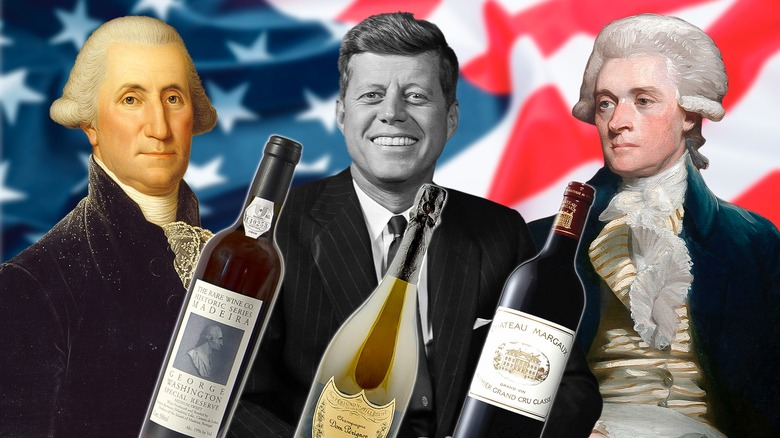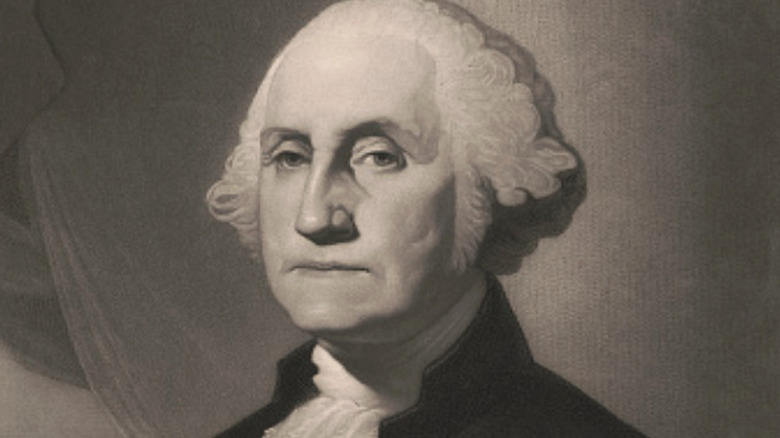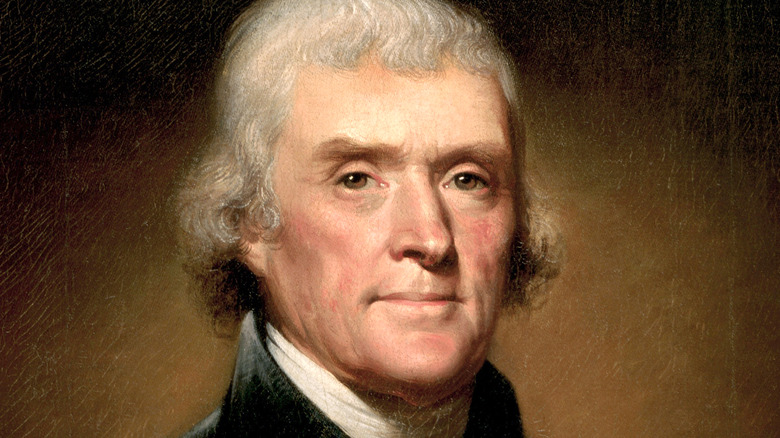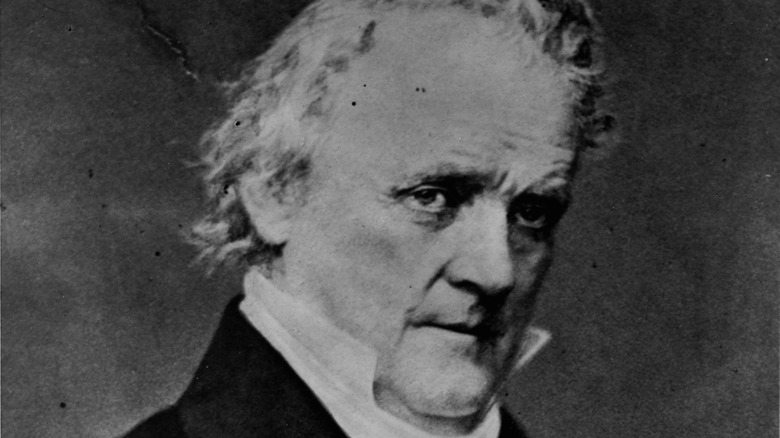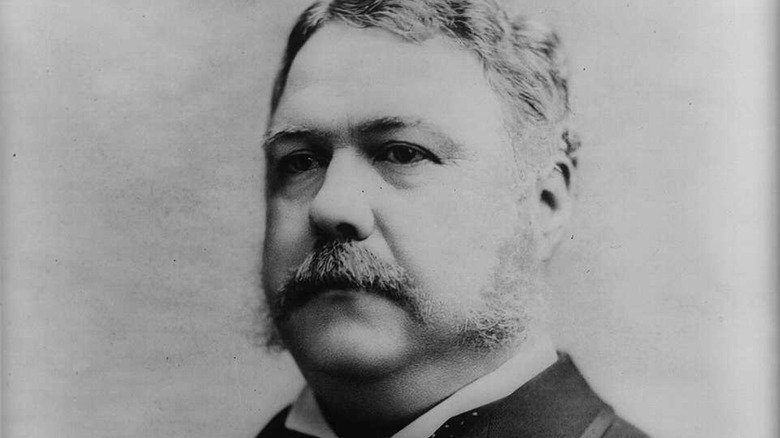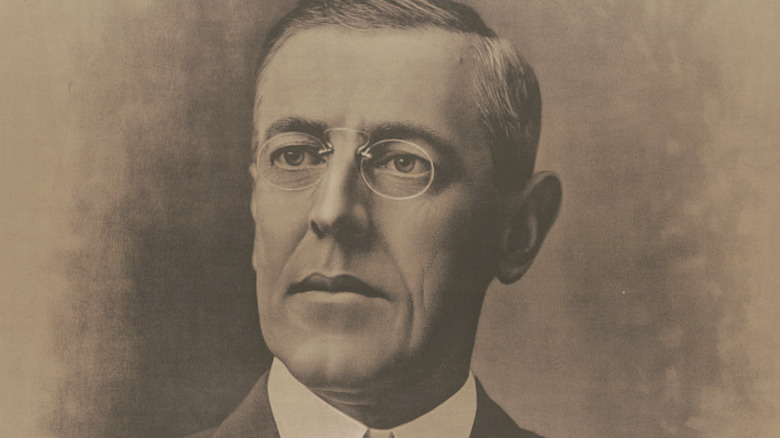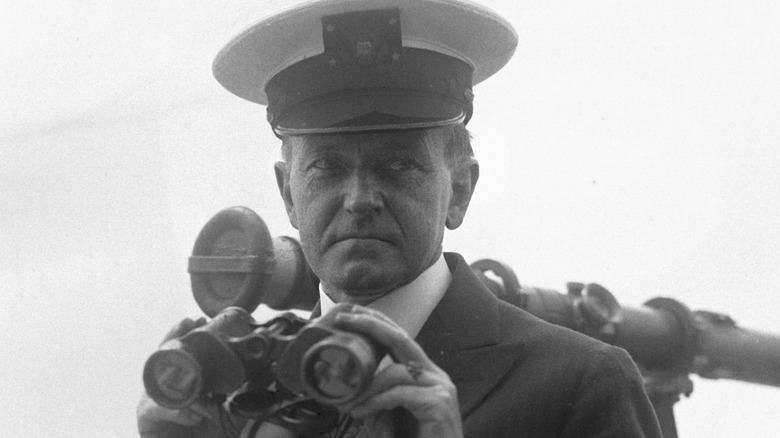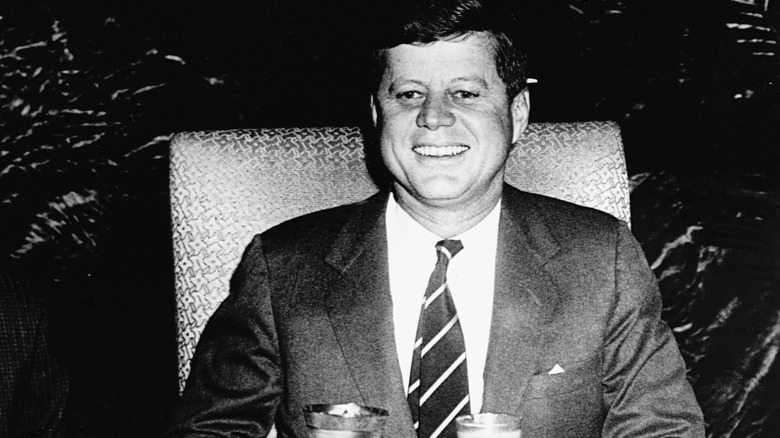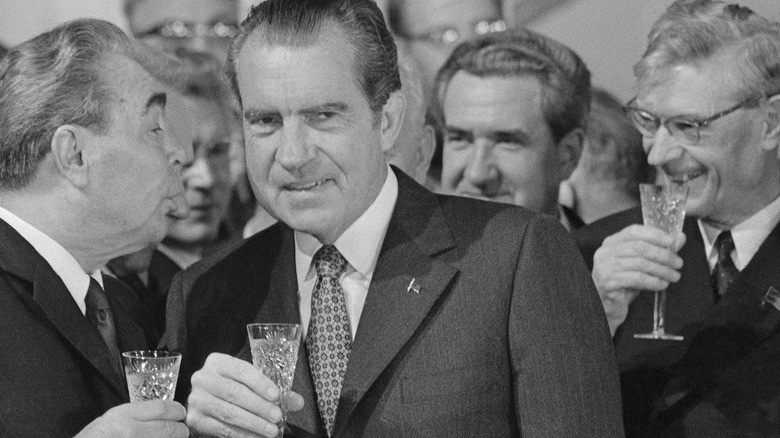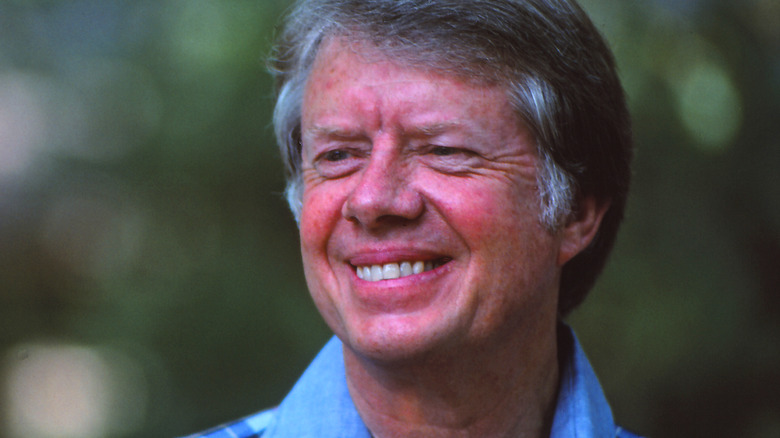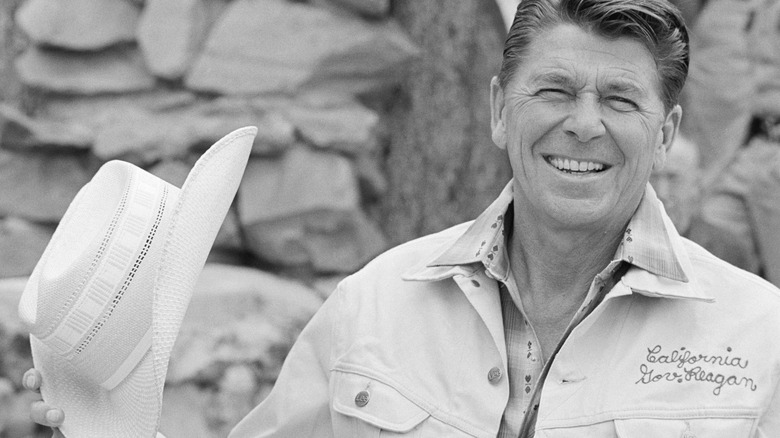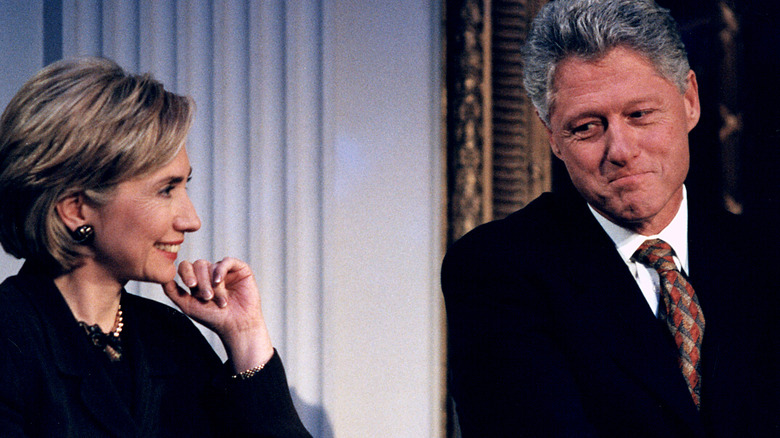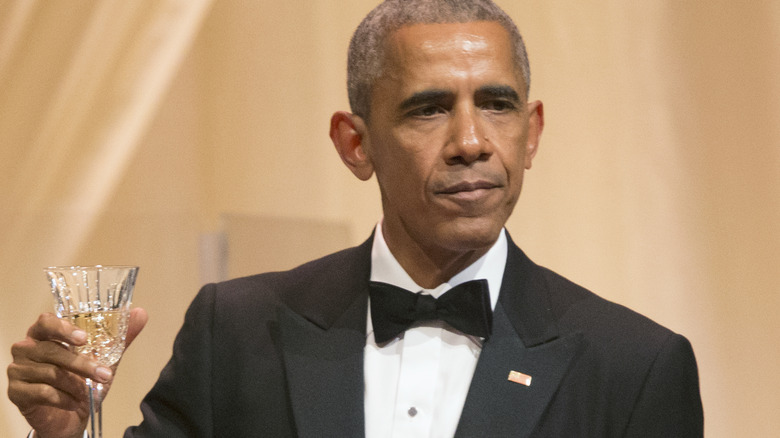12 Favorite Wines Of Former US Presidents
United States democracy as we know it was built on the principles of the Constitution ... and wine, lots and lots of wine. The Founding Fathers were serious wine enthusiasts who tipped a few back on the regular, alongside fellow colonial favorites ale and hard cider. The wine-swilling style of the nation's earliest leaders made the beverage a White House staple, a tradition that carries on today, even by presidents who barely drank at all. The presidents profiled here, were known for favoring particular types of wine.
The relationship between wine and politics has evolved. For one, White House parties don't get as wild as they did back in the day. Formal wine-drinking behaviors practiced in presidential quarters more closely resemble the elegant soirées First Lady Dolley Madison hosted in the early 1800s, rather than the let's-trash-the-place Inauguration Day banger thrown by Andrew Jackson (who mainly used wine as an ingredient in jungle juice).
Want to drink wine like the president? Well, you've got plenty of options. Take a cue from Thomas Jefferson, who probably sipped his glass pinky-out and gave "Top Chef" level summations of what he tasted. More into championing the locally grown stuff? That's what Ronald Reagan always did. Or maybe you're more of a Calvin Coolidge-type and prefer a solitary tipple in the evenings. Whether enjoyed in style or in secret, these wines were some of our past presidents' favorites.
George Washington popularized Madeira as the president's wine of choice
First U.S. President George Washington liked his wine fortified, and Madeira was the one that stole his heart. Madeira is named for the volcanic Portuguese island it has been produced on for centuries. Its fortification comes from adding brandy during the fermentation process. Fortifying the wine with brandy increased Madeira's alcohol by volume (ABV) content to between 18 and 20% and helped preserve the wine's sweet taste and rich body during long overseas voyages to the New World.
Long before he took office, Washington was working his connections with British supply companies to place bulk orders for Madeira. Records of Washington purchasing Madeira by the pipe — a quantity of approximately 126 gallons — date back to the spring of 1759. He ordered another pipe five years later (but swore he still hadn't tapped into the first batch) and would continue to place large Madeira orders for the rest of his life.
Madeira also appeared to be something of a social lubricant for Washington. He served Madeira and port to dinner guests at his Mount Vernon home and was known to down another three glasses post-meal. He wasn't the only founding father who kept the Madeira flowing — Benjamin Franklin, Alexander Hamilton, and future presidents John Adams, and Thomas Jefferson were fans. All of them clinked glasses of Madeira with Washington on special occasions, like after they signed the Declaration of Independence.
For Thomas Jefferson, only the finest wines would do
Different types of fortified wine, ranging from Madeira, to port, to sherry were hailed as the colonial era's classiest wines, and third president Thomas Jefferson enjoyed them. Yet, a man of Jefferson's exquisite palate wasn't satisfied with the status quo selections of the American political elite. In fact, he later dissed the robustly fortified wines of Portugal and Spain, claiming their tastes were symbolic of Britain's oppressive rule in the states.
What caused Jefferson to change his tune? France. In May 1784, Jefferson was appointed Minister Plenipotentiary to the Court of Versailles and set off to join John Adams and Benjamin Franklin in Paris. While abroad, he explored the vineyards of Bordeaux, Burgundy, and the Rhône Valley, reveled in Champagne (he preferred the still version), and sampled Nebbiolo, a sparkling wine from Northern Italy. He developed an affinity for lighter wines and was the first president to import and serve a variety of fine wines at the White House.
Bougie as he was, Jefferson didn't swear off fortified wines completely. A pale sherry from Spain and Termo port from Lisbon were two versions he thought highly of. At the time of his death, Jefferson's Monticello wine cellar was stocked almost exclusively with wines from the South of France. A wine enthusiast on Jefferson's level might struggle to choose a favorite, but according to the former president, "There couldn't be a better Bordeaux bottle" than Chȃteau Margaux.
James Buchanan loved his Madeira with a side of sherry (and whiskey)
Historians agree that 15th president James Buchanan was one of America's worst, mostly due to his indifference toward slavery in the years leading up to the Civil War. One thing Buchanan wasn't indifferent about was wine — or drinking in general. He came of age in the early 19th century — a time when drinking throughout the day was a socially acceptable notion — however, Buchanan could drink most people under the table with ease. One of his go-to beverages of choice was Madeira wine.
At Wheatland, Buchanan's estate in Lancaster, Pennsylvania, many of the former president's possessions have been preserved, including a sizable collection of empty alcohol bottles — save for an 1827 bottle of Madeira that sits unopened on his desk. Buchanan also drank sherry and rye whiskey faithfully, ordering a ten-gallon cask of Jacob Baer whiskey every Sunday. Describing Buchanan's proclivities, Fellow politician John W. Forney wrote, "The Madeira and sherry that he had consumed would fill more than one old cellar, and the rye whiskey that he has 'punished' would make Jacob Baer's heart glad."
Buchanan's high tolerance eventually caught up with him. His excessive consumption of alcohol and rich foods contributed to the gout that plagued him in his last years. Respiratory failure and rheumatic gout claimed Buchanan's life in 1868. He was 77 years old.
Chester A. Arthur was a fan of claret and after-dinner wines
New York City lawyer turned Vice President Chester A. Arthur was thrust into the executive seat in 1881 after the assassination of President James A. Garfield. Arthur wasn't a natural leader, but the guy had good taste. He hired a decorator to revamp the White House interiors, changed his tailor-made pants several times a day (he owned 80 pairs), and liked to wine and dine into the wee hours of the morn — because he could. To no one's surprise, his nickname was "Gentleman Boss."
Like Jefferson, Arthur found particular excitement in fine foods and libations. When he wasn't indulging in a mutton chop and a glass of ale, Arthur could be seen feasting on a slice of rare roast beef, baked potatoes, fruits, and a glass of claret wine. What is claret you ask? Claret is an archaic British term for the red blend wines of France's Bordeaux region.
Arthur dazzled at state dinners, where 378 wine glasses were furnished for 54 guests. Terrapin steaks, oysters, and fried macaroni pie accompanied the drinks, as did midnight tours of the White House. When he did work, Arthur took to his walnut desk, topped in leather and fitted with custom compartments that held a few cases of wine. Perpetual indulgence and a lack of exercise may have quickened the effects of Bright's disease, which afflicted his kidneys. Arthur died in 1886 at age 57, less than two years after leaving office.
Prohibition didn't stop Woodrow Wilson from enjoying champagne (and other wines)
Woodrow Wilson was in his second presidential term when Prohibition took effect in 1920. Despite Wilson's veto of the bill, Congress propelled the ban on alcohol into law. A presidential wine cellar was hardly anything new, but in the newfound Prohibition age, Wilson's wine cellar became a point of privacy.
What was in that hush-hush cellar exactly? Champagne and Bordeaux wines from France, likely gifts bestowed upon Wilson and First Lady Edith by Parisian diplomats. Wilson left office in 1921 with his health in ruins after suffering a stroke a couple of years earlier. When he moved out of the White House and into a nearby home at 2340 S Street in Washington D.C., Wilson insisted his wine cellar's contents move with him.
Legally speaking, transporting alcohol during Prohibition was a major no-no. Then again, Wilson had just been the president and presidents are known to bend the rules in their favor. Wilson may have wanted to continue his access to the respectable collection he'd accumulated in the wine cellar, which also contained scotch whiskey, another favorite, (the whiskey came with a prohibition-approved label designating the liquor for medicinal purposes). Still, more politically-minded motivations were possibly in play. The stringency of Prohibition brought out the worst in many so-called temperates — including incumbent president Warren G. Harding. It is believed that Wilson wanted the wines removed from the White House cellar because pseudo-sober Harding would drink it all.
Calvin Coolidge sipped Tokay in secret
President Calvin Coolidge was reserved to say the least. His taciturn nature earned him the nickname "Silent Cal," and unlike several presidents that served before him, he was far from a party animal. Though he wasn't a laugh riot in social scenarios, Coolidge did reach for the wine bottle from time to time — he just did it his way.
Coolidge's favorite wine was Tokay, or Tokaji. This sweet white wine from Northeastern Hungary was favored by Hungarian noblemen and royalty alike; Peter the Great, Catherine the Great, and King Louis XIV all had a thing for Tokay. The 30th president was inclined to partake in a glass of Tokay, in private. Preferring to drink alone tracks with what is known about Coolidge's personality, but there was a more pressing motivation behind his penchant toward solitude.
Prohibition was alive and well during Coolidge's presidency, though he had campaigned against it during his bid for governor of Massachusetts. Pensive Tokay sessions aside, Coolidge set a dutiful example for the nation and abstained from drinking in public — even while outside America's borders. On a now legendary 1928 trip to Cuba for a state dinner where he was the guest of honor, Coolidge was invited to down an El Presidente cocktail or two, plus a few rare wines and a vintage brandy from 1811. The rum cocktail was Cuban President Gerardo Macahdo's favorite, and the press clamored over whether Coolidge would drink one, but he didn't.
John F. Kennedy emulated James Bond with some Dom Perignon
When the Kennedys lived at the White House, style and sophistication reigned supreme and this certainly extended to President John F. Kennedy's choice of wine. Unsurprisingly, state dinners hosted by the Kennedys were decked out with a healthy supply of Champagne and French wines. The First Lady was partial to champagne, while President Kennedy swore his allegiance to Dom Perignon. His reasons for gravitating toward this wine were the stuff of boyish fantasy.
Kennedy's favorite wine was Dom Perignon because it was James Bond's favorite wine. The president was an ardent reader of Ian Fleming's James Bond novels and a fan of the film adaptation of "Dr. No" released shortly before Kennedy's assassination in November 1963. As Mrs. Kennedy gingerly sipped a flute of Veuve Clicquot within the White House rooms she redecorated with such meticulousness it warranted a T.V. special, her husband donned his finest suits, swilled Dom Perignon, and perhaps imagined the swanky foundation dinners he participated in were the glamorous end of more actionable missions. The name's Kennedy. John F. Kennedy.
Richard Nixon had a thing for Chȃteau Margaux ... but didn't like to share
Even a brief perusal of Richard Nikon's political career shows that he was a complicated man in and out of office. Nixon's neuroses were always running high, and one way this pathology manifested was in his behavior surrounding booze. Historical accounts have branded the 37th president as an emotional drinker, who drunk dialed members of staff and kept them on the phone until he fell asleep. During the Watergate scandal, Nixon spilled his guts more than once to the bartender at his local D.C. haunt, Trader Vic's. When it came to his favorite wine, he was equally cagey.
Nixon loved Chȃteau Margaux, a Bordeaux long thought of as one of the best wines of the world. Whether hosting a state dinner or raising a toast with fellow leaders in hopes of easing Cold War tensions, if Nixon had any pull on what was being poured, he made sure the contents of his glass were top notch.
Before Watergate made Nixon infamous, he was a notorious punch-puller. The former president made a point to serve his guests cheap wine while he downed glasses of 1966 Chȃteau Margaux right in front of them. Nixon assumed his company was none the wiser, but this turned out not to be the case. This brazen party foul was eventually known as "pulling a Nixon."
Jimmy Carter's favorite wine might have been his own
When President Jimmy Carter took office in 1977, he was set on making some changes about the White House's relationship with alcohol. During his four years there, Carter proclaimed that liquor would be banned at White House functions. Wine would still be served though, and Carter took it upon himself to stock high-quality, domestic wines from California and New York.
Prior to assuming the presidency, Carter, a lifelong resident of Plains, Georgia, was a peanut farmer who came from a long line of agricultural professionals. Among the crops his family grew were grapes to make their own wine, which explains his affinity for domestic bottles. Carter inherited his grandfather's wine recipe and five-gallon wine jugs from his father. He put both to good use after leaving office and spent much of his post-presidential life making wine.
Carter took wine production pretty seriously. He and wife Rosalyn traveled the globe, and made a point to taste the wines made in nations where viniculture is understated. In a 2005 interview with Wine Spectator, Carter called the wine made in South Africa "outstanding" and bottles from Palestine "very good." Back home, Carter produced around 100 bottles of wine every five years, 75 reds and 25 whites — but he never sold a single one. He preferred to give them away.
Ronald Reagan kept it California
You can take the president out of Hollywood but you can't take Hollywood out of the president. For 40th president Ronald Reagan, California wine culture was a point of patriotic pride. He eschewed the high society wines of Western and Central Europe to celebrate more personal tastes. With Reagan at the helm, the wine list at White House banquets and formal dinners was predominantly Californian (or at the very least domestic).
Reagan had built relationships with winemakers in California while he was the governor there. Once he ascended to the presidency, Reagan made an effort to serve wine from a diverse number of California vineyards, though he had a soft spot for Schramsberg sparkling wine and the vineyards of Jordan and Robert Mondavi. The president's consistent focus on celebrating wines from his adopted home state helped these regional wines gain greater visibility on the modern wine market.
The president believed California wines deserved a moment of glory on the international stage as well. In 1982, Reagan toted two Napa Valley wines and a Napa Valley Champagne along on his tour of Europe. Vintage bottles of Grgich Hills Chardonnay and Heitz Cabernet Sauvignon were famously served when Reagan dined with then-President of France, François Mitterand.
Bill Clinton favored wines from Talley Vineyards
Bottles from Talley Vineyards, a winery based in Central California's Arroyo Grande Valley, were a familiar presence at fancy White House functions during the Clinton administration. Clinton enjoyed wine, (though a lager and hard cider hybrid known as a Snakebite is said to be the president's favorite alcoholic drink), but didn't have the passion for it the way some former presidents did. Talley Chardonnay and Pinot Noir had President Clinton's approval and made recurring appearances at state dinners and other official events, but the idea to serve them wasn't his.
Early into Clinton's first term, First Lady Hilary Clinton wanted to bring fresh talent into the White House's culinary staff. She brought in Daniel Shanks, a former wine director at the esteemed Domaine Chandon winery in Napa Valley to oversee the executive wine selection. Shank's appointment marked the first time a wine professional had ever been employed at the White House. The Clintons' embrace of Talley Vineyards wine was a trendsetting move. George W. Bush, who succeeded Clinton as president, served Talley Vineyards wine at official state dinners, holiday parties, and even quaint meals.
Barack Obama's fondness for Peza do Rei Ribeira Sacra made this wine hard to come by
When Barack Obama moved into the White House in 2008, he brought with him a charisma and modernity that hadn't been seen in a while. From the beginning the public took great interest in Obama's personal tastes, especially in regard to what he liked to eat and drink. When the 44th president gave a shout out to a particular eatery, beverage, or snack, his fellow Americans paid attention. That's exactly what happened when Obama served Peza do Rei Ribeira Sacra at the Gala de la Hispanidad in Washington D.C..
Obama's chosen wine for the occasion, which honored the Hispanic community's contributions to U.S. history, wasn't just spot on — it was viral. Highlighting a white wine from Northwest Spain's Galicia region was not something that had not really been done at the White House in administrations past. Serving Peza do Rei Ribeira Sacra wine for this specific occasion struck a chord of perfection.
Peza do Rei Ribeira Sacra is characterized by a fruity, floral flavor and retains a full bodied mouthfeel without being too heavy. After the gala, Pieza do Rei began selling out all over Spain, with the majority of purchases being made by customers in the United States It swiftly earned the moniker of "Obama's wine" and was hard to come by for months and months afterward.
